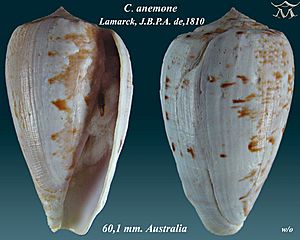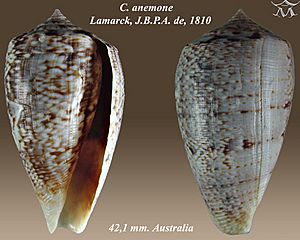Conus anemone facts for kids
Quick facts for kids Conus anemone |
|
|---|---|
 |
|
| Apertural and abapertural views of shell of Conus anemone Lamarck, J.B.P.A. de, 1810 | |
 |
|
| Scientific classification | |
| Synonyms | |
|
The anemone cone (Conus anemone) is a fascinating type of sea snail. It is a marine gastropod mollusk that belongs to the Conidae family, commonly known as the cone snails. These snails are found in the ocean and are known for their beautiful, cone-shaped shells.
Like all species in the Conus group, these snails are hunters and can be venomous. This means they have a special way to catch their food, but they can also sting humans. Because of this, it is very important to be careful and avoid touching live anemone cones if you ever see one.
Scientists have noticed that Conus anemone can look quite different from one snail to another. Some look so different that they were once thought to be separate species! This is why there are many old names for what is now considered to be Conus anemone. For example, a very large type found in South Australia, called C. peronianus, is still being studied to see if it is truly a part of Conus anemone or its own species.
What is a Subspecies?
Sometimes, scientists group animals into smaller categories called subspecies. This happens when there are slight but consistent differences within a species. For example, Conus anemone has a recognized subspecies called Conus anemone novaehollandiae.
Scientists sometimes disagree on whether a group is a subspecies or a completely separate species. For Conus anemone novaehollandiae, some experts consider it a subspecies of C. anemone. However, other specialists in Australia believe it is a distinct species. This is because there are differences in how they look and where they live. There is also a large gap of about 600 kilometers between where the northernmost anemone populations live and the southernmost novaehollandiae populations are found.
Shell Description
The shell of the anemone cone can vary a lot in size, from about 21 mm (less than an inch) to 93 mm (about 3.5 inches) long. Its shape can also differ. Some shells are short and strong with a short spire (the pointed top part). Others are longer and more slender, with a taller spire.
Both the spire and the main part of the shell, called the body whorl, have close, ridged lines all over them. The shell is usually white. It often has patterns of chestnut or chocolate brown, which can look like clouds or a net. There is usually an irregular white band in the middle of the shell. The opening of the shell, called the aperture, is often chocolate-colored with a white band in the middle.
Where Do They Live?
The anemone cone is found only in Australia. You can find this species living off the coasts of New South Wales, South Australia, Tasmania, Victoria, and Western Australia.

